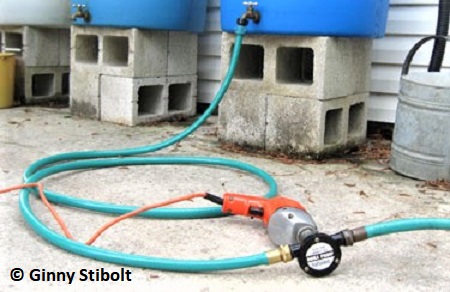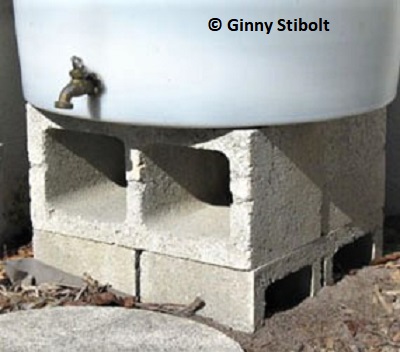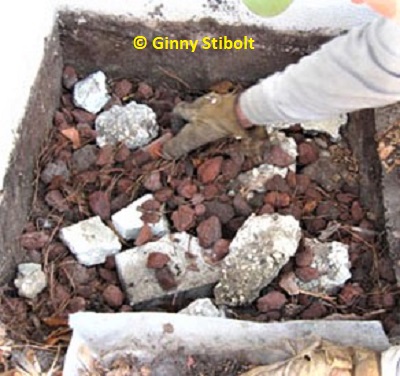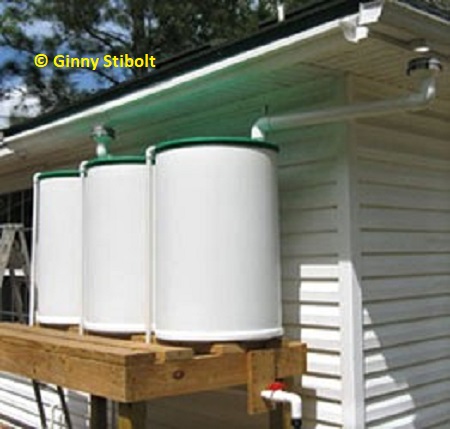Three more rain barrels
by Ginny Stibolt
We've used four rain barrels for several years, which I wrote about
in these two articles: Climb up my rain barrels
and Rain barrels revisited. We've been
happy with them and have used the saved rainwater in many ways, but
as we expanded the vegetable gardens, we wanted an easier way to provide
the extra water they need without slogging the watering cans around
the garage.
Our first step was to pick up three barrels at a local bottling plant.
These barrels had contained syrup for an energy drink. It's important
to use food grade barrels, not ones that have contained petroleum products
or poisons.
Using Gravity
Each of the original three barrels on the other side of the garage
sits on four cinder blocks piled two-high, so when I attached a hose
to one of the barrels, I had to keep it low or there would be no flow.
For this new set of barrels Dean, my husband, built a four-foot high
deck to elevate the new barrels so the force of gravity provides some
water pressure. The three new barrels would be tied together with a
series of pipes through bottom fittings so that all the barrels fill
up and drain together. (Unlike our other series of three barrels where
the first barrel fills and its overflow runs into the second barrel
and when the second barrel fills it overflows into the third barrel.)
This new arrangement means that we use the one spigot and do not have
to keep track of which barrels are empty or full. Using a hose attached
to the spigot to water the vegetable beds requires no bending over,
no waiting for watering cans to fill, and no hauling. Yippee!
The garage has metal gutters installed on the front and on the side
closest to the house. The new barrels collect rainwater from the side
near the house, while the other three collect rainwater from the front
gutter. Once we installed the barrels, we decided to install a stand-alone
ten-foot plastic gutter right over these barrels to collect more water.
To estimate how much water you can expect to collect, calculate the
area of the roof, no matter what its slope, and multiply by 0.6. This
is the number of gallons you can expect for every inch of rain. For
this example: 15' x 10' = 150square feet/2 (Divide by 2 because it's
a hip roof and is a triangle.) = 75 square feet. 75 x 0.6 = 45 gallons
per inch of rainfall. So that extra ten feet of gutter will almost
fill an extra barrel for every inch of rain.
Each of the barrels has its own overflow pipe. The three overflow pipes
are connected to another pipe that takes the excess water away from
the platform during heavy storms. This will help prevent undermining
the footings of the platform when the rain barrel water is not used
as fast as the rainfall. In preparation for a tropical storm,
we will hook up a temporary hose that will carry excess water out to
a wooded are to prevent too much water from overflowing in that one
place.
The dry season
We put the rain barrel system in place during the dry season. This
allowed us to test for leaks without being surprised by too much rainfall.
My husband purchased a pump to transfer rainwater from the old barrels
and back again.
Instead of spending about $80 for a pump with its own
motor, he spent $7 for a drill pump that uses the motor of an electric
hand drill to power the pump. To create the hookup to the barrel to
be emptied, Dean custom-made a short hose with female connectors on
each end. Soon all the water from the old barrels, which were relatively
full from a half inch of rain the previous week, was pumped into the
new barrels.
 << To test the new barrels,
the drill pump moved water from the old rain barrels to the new ones. He
used an old ¼" electric drill, which will now be a dedicated pump motor.
<< To test the new barrels,
the drill pump moved water from the old rain barrels to the new ones. He
used an old ¼" electric drill, which will now be a dedicated pump motor.
Removing all the water from the original barrels also
provided a good opportunity to rinse them out, clean out behind the
cinder blocks, and move them a little closer to the front of the garage
to make more space in the potting bench area on that wall.
The new barrel system works well and the veggies are now much easier
to water. For more information and photos of the construction and hook
up see: Three rain barrels: Construction
overview.
A sinking rain barrel
 Our stand-alone barrel also
needed attention. Four years ago when we placed the four cinder blocks
on the soil next to the house, it didn't occur to us that red fire ants
could cause a rain barrel to sink. Not long ago, we noticed an ant mound
developing adjacent to the cinder block base. Within a few weeks after
we noticed the ants, the bottom cinder blocks holding the barrel were
more than half buried. It wasn't that the mound was getting higher,
but rather that the blocks were sinking into the ground. Since a full
rain barrel weighs more than 400 lbs, you need a stable, solid
base. The ants had undermined the soil with their tunnels, and the barrel
began to sink. Our stand-alone barrel also
needed attention. Four years ago when we placed the four cinder blocks
on the soil next to the house, it didn't occur to us that red fire ants
could cause a rain barrel to sink. Not long ago, we noticed an ant mound
developing adjacent to the cinder block base. Within a few weeks after
we noticed the ants, the bottom cinder blocks holding the barrel were
more than half buried. It wasn't that the mound was getting higher,
but rather that the blocks were sinking into the ground. Since a full
rain barrel weighs more than 400 lbs, you need a stable, solid
base. The ants had undermined the soil with their tunnels, and the barrel
began to sink.
We used the water from this barrel exclusively for a few
days, including a good soaking of shrubs that I've planted within the
last year. When the barrel was empty, Dean dismantled the
diverter (See Rain Barrels Revisited for
details.) and removed the barrel and cinder blocks.
 To establish a new base, first
we used fire ant poison to kill the colony. Then we dug down a good
two feet and filled the hole with leftover cement chunks and leftover
lava rocks. This rocky substrate serves two purposes: 1) It discourages
ants because they prefer to colonize soil of finer consistency, and
2) It forms a deeper, more solid base for our cinder block platform. To establish a new base, first
we used fire ant poison to kill the colony. Then we dug down a good
two feet and filled the hole with leftover cement chunks and leftover
lava rocks. This rocky substrate serves two purposes: 1) It discourages
ants because they prefer to colonize soil of finer consistency, and
2) It forms a deeper, more solid base for our cinder block platform.
We placed the cinderblocks on the rocks and made sure
that they were solidly in place and level in all directions. Since this
barrel is next to the house even a couple of degrees from level would
look sloppy.
While the barrel was empty, Dean cleaned out the algae
before he reassembled the parts. Now it's contributing to our rainwater
supply again.
Seven barrels!
When I tell people I have seven rain barrels, they can't
believe it. But over the years we've come to depend on this supply of
soft, chemical-free water for our inside plants, porch plants, and outside
plants when general irrigation is not on or not adequate for certain
plants, such as seedlings, transplants, and the vegetable gardens.
In the winter when the lawn is dormant, we only turn on the irrigation
system, which pumps water from the lake, once a month for only a few
minutes to exercise all the parts. The rain barrel water is most important
during this period.
In addition to using
water for plants, we use the rain barrel water for:
· pre-rinsing veggies.
· pre-rinsing hands, feet, and maybe even dirty gardening
socks.
· rinsing gardening gloves and muddy tools.
· wetting the compost piles.
· cleaning out pots and planters.
· washing our vinyl rail fence annually.
· and much more.
I hope you consider installing some rain barrels on your
property. As the cost of city and county water rises, rain barrels
provide "Savings for a Sunny Day!"
(Update: The oldest barrel that
we'd brought from Maryland cracked, so now we have six barrels, which
usually supplies us with enough water for our needs--even during the
winter dry season, which is when we grow the most vegetable crops.)
| 


 << To test the new barrels,
the drill pump moved water from the old rain barrels to the new ones. He
used an old ¼" electric drill, which will now be a dedicated pump motor.
<< To test the new barrels,
the drill pump moved water from the old rain barrels to the new ones. He
used an old ¼" electric drill, which will now be a dedicated pump motor.
 Our stand-alone barrel also
needed attention. Four years ago when we placed the four cinder blocks
on the soil next to the house, it didn't occur to us that red fire ants
could cause a rain barrel to sink. Not long ago, we noticed an ant mound
developing adjacent to the cinder block base. Within a few weeks after
we noticed the ants, the bottom cinder blocks holding the barrel were
more than half buried. It wasn't that the mound was getting higher,
but rather that the blocks were sinking into the ground. Since a full
rain barrel weighs more than 400 lbs, you need a stable, solid
base. The ants had undermined the soil with their tunnels, and the barrel
began to sink.
Our stand-alone barrel also
needed attention. Four years ago when we placed the four cinder blocks
on the soil next to the house, it didn't occur to us that red fire ants
could cause a rain barrel to sink. Not long ago, we noticed an ant mound
developing adjacent to the cinder block base. Within a few weeks after
we noticed the ants, the bottom cinder blocks holding the barrel were
more than half buried. It wasn't that the mound was getting higher,
but rather that the blocks were sinking into the ground. Since a full
rain barrel weighs more than 400 lbs, you need a stable, solid
base. The ants had undermined the soil with their tunnels, and the barrel
began to sink.  To establish a new base, first
we used fire ant poison to kill the colony. Then we dug down a good
two feet and filled the hole with leftover cement chunks and leftover
lava rocks. This rocky substrate serves two purposes: 1) It discourages
ants because they prefer to colonize soil of finer consistency, and
2) It forms a deeper, more solid base for our cinder block platform.
To establish a new base, first
we used fire ant poison to kill the colony. Then we dug down a good
two feet and filled the hole with leftover cement chunks and leftover
lava rocks. This rocky substrate serves two purposes: 1) It discourages
ants because they prefer to colonize soil of finer consistency, and
2) It forms a deeper, more solid base for our cinder block platform.